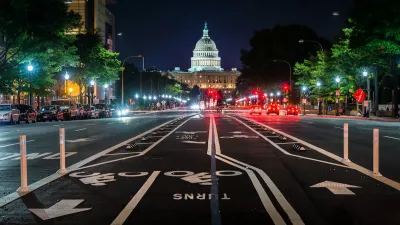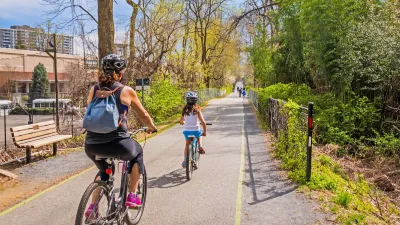Minor pedestrian-oriented improvements alone won't improve walkability if infrastructure still prioritizes fast-moving vehicles, according to this article.

Pedestrian infrastructure projects too often prioritize faster car traffic and fail to implement real protective measures for people walking, argues Joe Cortright. Houston's Energy Corridor, which recently received a high-profile "pedestrian makeover," provides a prime example of the "remedial and performative" projects that, according to Cortright, project the appearance of walkability while maintaining "an auto-dominated and pedestrian hostile environment." With 60,000 cars passing through every day, the newly renovated intersection, with its dangerous "slip lanes," offers minimal safety for pedestrians and cyclists. Aside from the lack of real protection for pedestrians, the area suffers from a lack of walkable destinations. "Pro-tip: any area that describes itself as a 'corridor' is almost always an auto-dominated, pedestrian-hostile space, a place people travel through, rather than being in."
Cortright points to similar examples in other cities, asserting that "much of what purports to be 'pedestrian' infrastructure, is really car infrastructure, and is only necessary in a world that’s dominated by car travel." True pedestrian infrastructure, he writes, includes density, walkable destinations, and fewer, slower cars. "Walkability and pedestrian safety are really about building great places, not piecemeal and largely decorative so-called infrastructure."
FULL STORY: More performative pedestrian infrastructure

Planetizen Federal Action Tracker
A weekly monitor of how Trump’s orders and actions are impacting planners and planning in America.

Maui's Vacation Rental Debate Turns Ugly
Verbal attacks, misinformation campaigns and fistfights plague a high-stakes debate to convert thousands of vacation rentals into long-term housing.

Restaurant Patios Were a Pandemic Win — Why Were They so Hard to Keep?
Social distancing requirements and changes in travel patterns prompted cities to pilot new uses for street and sidewalk space. Then it got complicated.

In California Battle of Housing vs. Environment, Housing Just Won
A new state law significantly limits the power of CEQA, an environmental review law that served as a powerful tool for blocking new development.

Boulder Eliminates Parking Minimums Citywide
Officials estimate the cost of building a single underground parking space at up to $100,000.

Orange County, Florida Adopts Largest US “Sprawl Repair” Code
The ‘Orange Code’ seeks to rectify decades of sprawl-inducing, car-oriented development.
Urban Design for Planners 1: Software Tools
This six-course series explores essential urban design concepts using open source software and equips planners with the tools they need to participate fully in the urban design process.
Planning for Universal Design
Learn the tools for implementing Universal Design in planning regulations.
Heyer Gruel & Associates PA
JM Goldson LLC
Custer County Colorado
City of Camden Redevelopment Agency
City of Astoria
Transportation Research & Education Center (TREC) at Portland State University
Jefferson Parish Government
Camden Redevelopment Agency
City of Claremont





























